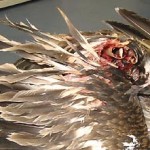A female shorebird was recorded in 2007 to have flown 7,145 miles or 11,500 kilometers nonstop from Alaska to New Zealand—without taking a break for food or drink.

A flight-time integrator for birds
This note provides a preliminary account of
our efforts to facilitate studies of flight behavior hy designing and developing a
device for measuring the total time spent in flight by birds.
In conjunction with our developingi nterest in studying the hioenergeticso f the Laysan Albatross (Diomedea immutabilis), we wanted specifically to learn what proportions of the total time at sea were spent in flight and on the water. Our instrument provides this measurement hy respondinge lectrochemicallyd uring the individual periods when a bird to which
the unit is attached rests on the water; these response times are accumulated, or
(mathematically speaking) integrated, to provide the total period of activity. Accuracy is increased by a second, continuously operating circuit which records the total time and thus makes calibration possible.
Additional information with respect to
the time of day during which the recorded activity occurs is, within broad limits,
obtainable. The unit therefore provides the following minimum information: (1)
the total time of operation (i.e., for our intended use, the total time the birds are
away from the nests and out to sea); (2) the total time of daylight (or some preselected
level of illumination); (3) the total time spent on the water; and (4) the
total time of activity (on-water) with the selected level of illumination (daylight).
Several alternative methods were considered for gathering the desired information
and we concluded that the use of a minaturized electroplating system for measuring
the time intervals was most promising and least demanding in terms of cost
and effort.
The principle of operation is based on one expression of Faraday’s law
which states that the number of ions liberated from solutions of various electrolytes
is directly proportional to the total current passing through the solution. That is, if
one has an electroplating solution and conducts a current through it, a part of the ions
in solution will he deposited on one of the electrodes (the cathode or negative
electrode) in an amount related to the current being conducted. If the rate of the
current is constant, the deposition of ions will he proportional to the duration of
current flow. Hence, the length of time of the current flow can he determined hy
weight changes of the cathode. With careful weighing, we could obtain 99 per cent
accuracy.




